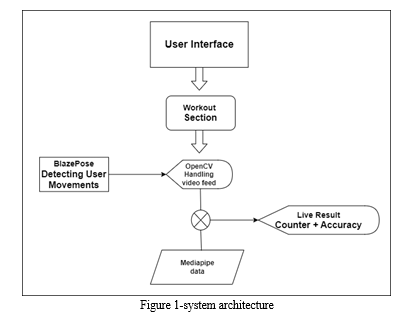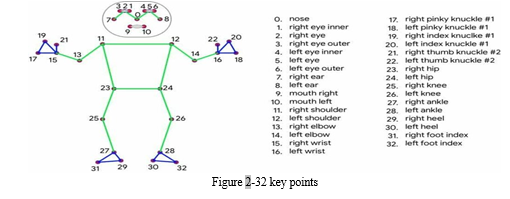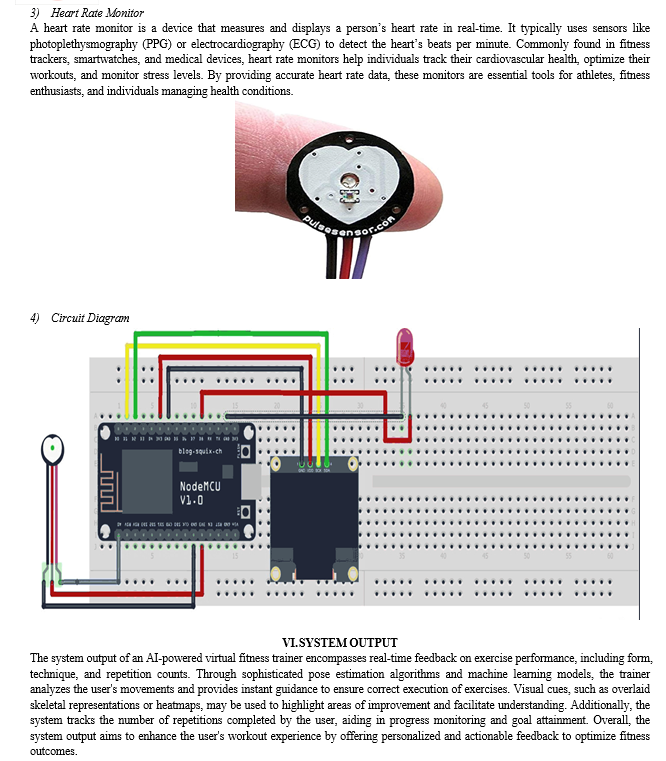Ijraset Journal For Research in Applied Science and Engineering Technology
- Home / Ijraset
- On This Page
- Abstract
- Introduction
- Conclusion
- References
- Copyright
Virtual Fitness Trainer Using AI: A Research Paper
Authors: Mr. H. P. Chaudhari, Akram Faras, Mitej Patil
DOI Link: https://doi.org/10.22214/ijraset.2024.62505
Certificate: View Certificate
Abstract
Our research delves into the creation of a Virtual Fitness Trainer using Artificial Intelligence (AI) to offer personalized workout guidance and real-time feedback. This project harnesses advanced computer vision, machine learning, and natural language processing techniques to develop an intelligent system capable of accurately detecting human poses, tracking exercise repetitions, and providing corrective feedback. Utilizing Python\'s OpenCV library to capture live webcam feeds, processed by MediaPipe\'s BlazePose tool for precise pose estimation, our application employs a novel topology with 33 keypoints, enhancing the accuracy of body movement analysis. The frontend interface, designed with Flask, HTML, CSS, and Bootstrap, ensures an intuitive user experience, allowing selection from various exercises such as squats, curls, jumping jacks, push-ups, lateral raises, and pull-ups. Each exercise page offers detailed instructions and demonstration videos for correct technique execution. The system processes live video streams frame-by-frame, converting them into formats suitable for pose analysis and accuracy assessment. BlazePose tracks user movements in real-time, displaying a 33-keypoint exoskeleton via OpenCV, aiding in understanding body movements and tracking progress through repetition counts. The system also provides real-time feedback on exercise form, suggesting corrective actions to optimize the workout and minimize injury risks. Our Virtual Fitness Trainer addresses the limitations of existing fitness apps by enabling accurate, independent home workouts, bridging the gap left by the absence of gyms and personal trainers. It highlights AI\'s potential in fitness, with future advancements expected to enhance gesture recognition, adaptive workout plans, and integration with biometric data from wearables. As AI algorithms evolve, the Virtual Fitness Trainer aims to become indispensable for achieving health and wellness goals, offering a convenient, engaging, and supportive platform.
Introduction
I. INTRODUCTION
In the modern era, the convergence of artificial intelligence (AI) and fitness technology has sparked a wave of innovation, giving rise to Virtual Fitness Trainers empowered by advanced computational techniques. These trainers represent a transformative approach to fitness training, offering users personalized exercise guidance, real-time feedback, and motivation, all within the comfort and convenience of their own homes. As sedentary lifestyles become increasingly prevalent and the importance of physical activity for overall health gains recognition, the need for accessible, tailored, and effective fitness solutions has never been more pronounced. Traditional fitness avenues, such as gym memberships and personal training sessions, often pose barriers in terms of cost, accessibility, and time constraints, limiting their reach and impact. In response to these challenges, this research endeavors to explore the disruptive potential of AI-powered Virtual Fitness Trainers in the fitness landscape. By harnessing cutting-edge technologies including computer vision, machine learning, and natural language processing, these virtual trainers offer users a holistic fitness experience that adapts to their individual needs and preferences. This paper seeks to delve into the development, implementation, and potential benefits of such virtual trainers, shedding light on their underlying technologies, features, and implications for the future of fitness training. Through a meticulous examination of existing literature, we aim to illuminate the strides made in AI-driven fitness technology, encompassing studies on gesture recognition, pose estimation, machine learning algorithms for personalized workout plans, and the integration of wearable devices for biometric data tracking. Furthermore, we endeavor to elucidate both the advantages and challenges associated with Virtual Fitness Trainers, addressing concerns such as the accuracy of pose estimation, user engagement, and data privacy. Our research also endeavors to provide a practical demonstration of a Virtual Fitness Trainer using AI, offering insights into its system architecture, frontend interface design, and key functionalities including exercise selection, real-time pose analysis, repetition tracking, and feedback mechanisms. By showcasing the capabilities of our virtual trainer prototype and sharing the development process, we aim to contribute to the expanding realm of AI-powered fitness technology and inspire further exploration and innovation in this dynamic field.
II. LITERATURE REVIEW
In recent years, there has been a notable convergence of artificial intelligence (AI) with fitness technology, resulting in the emergence of Virtual Fitness Trainers that offer a revolutionary approach to exercise guidance and feedback. These innovative platforms harness advanced computational techniques such as computer vision, machine learning, and natural language processing to deliver personalized workout routines and real-time assistance to users. For example, Patil et al. (2022) conducted research focusing on the development of an AI-based personal fitness trainer, demonstrating the potential of AI algorithms to tailor exercise plans based on individual preferences, fitness levels, and goals. Additionally, studies by Casilli et al. (2021) have explored the application of machine learning algorithms for the recognition of physical activities, showcasing the effectiveness of AI technologies in accurately identifying various types of exercises performed by users. Furthermore, Farrokhi et al. (2021) conducted a survey highlighting the integration of Internet of Things (IoT) and AI for smart fitness applications, emphasizing the potential of Virtual Fitness Trainers to track biometric data from wearable devices, providing users with comprehensive insights into their workout performance and progress. By leveraging these cutting-edge technologies, Virtual Fitness Trainers offer a holistic and personalized approach to fitness training, empowering users to achieve their health and wellness goals more effectively.
III. METHODOLOGY
- Data Collection and Preparation
- Gather a diverse dataset of exercise videos covering a wide range of activities, body types, and fitness levels.
- Preprocess the collected data to remove noise, standardize formats, and enhance the quality of the dataset.
- Annotate the dataset with ground truth labels for exercises, body keypoints, and repetition counts.
2. Pose Estimation
- Implement state-of-the-art pose estimation algorithms such as OpenPose, PoseNet, or BlazePose to detect and track key points on the user's body in real-time.
- Fine-tune the pose estimation models on the annotated dataset to improve accuracy and robustness.
3. Exercise Recognition
- Train machine learning or deep learning models, such as convolutional neural networks (CNNs) or recurrent neural networks (RNNs), to recognize different exercises based on the detected poses.
- Use transfer learning techniques to leverage pre-trained models for faster convergence and improved performance.
4. Repetition Counting
- Develop algorithms to accurately count repetitions for each exercise, incorporating motion analysis techniques and pattern recognition algorithms.
- Implement heuristic methods or deep learning models to infer repetitions from temporal sequences of poses.
5. Feedback Generation
- Design feedback mechanisms that analyze users' exercise performance in real-time and provide actionable feedback on form, technique, and progression.
- Utilize visualization techniques such as heatmaps, skeletons, or overlay graphics to visually represent feedback to users.
6. User Interface Development
- Create an intuitive and user-friendly interface for the virtual trainer application, allowing users to interact with the system seamlessly.
- Incorporate features such as exercise selection, video playback, progress tracking, and feedback display to enhance the user experience.
7. Integration with Wearable Devices
- Integrate the virtual trainer with wearable devices such as fitness trackers, heart rate monitors, or smartwatches to collect additional biometric data during workouts.
- Use APIs or SDKs provided by wearable device manufacturers to enable seamless data exchange between the virtual trainer and wearables.
8. Testing and Evaluation
- Conduct rigorous testing and evaluation of the virtual trainer system, including functional testing, performance testing, and user acceptance testing.
- Collect feedback from beta testers and end-users to identify usability issues, bugs, and areas for improvement.
9. Iterative Improvement
- Continuously iterate and refine the virtual trainer system based on user feedback, performance metrics, and technological advancements.
- Incorporate user feedback into the development process to address usability concerns, enhance feature functionality, and optimize performance.
10. Deployment
- Deploy the finalized virtual trainer system for public use on web platforms, mobile devices, or standalone applications.
- Ensure scalability, reliability, and security of the deployed system, adhering to best practices in software engineering and cybersecurity.
IV. SYSTEM ARCHITECTURE
The system architecture of the Virtual Fitness Detector using AI is designed to integrate various components seamlessly to deliver an effective and user-friendly experience. At its core, the architecture employs a combination of front-end and back-end technologies to capture, process, and analyze user movements in real time. The front-end interface, developed using HTML, CSS, and JavaScript, allows users to select exercises, view live feedback, and receive guidance. The back-end leverages Python and Flask to handle data processing and server requests. The critical component of pose estimation is powered by the BlazePose model from MediaPipe, which utilizes a 33-key-point detection method to accurately track and analyze user movements. This data is processed in real-time, and OpenCV is used to visualize the key points and provide feedback on the user's form. The architecture also includes a machine learning module that continuously learns from user interactions to offer personalized workout recommendations. This robust and scalable architecture ensures that users receive accurate, real-time feedback, making their workout sessions more efficient and safe.

- User Interface: The user interface of the Virtual Fitness Detector using AI is designed to be intuitive and user-friendly. It features a clean layout with clearly labeled sections for selecting exercises, viewing instructions, and accessing live feedback. Users can easily navigate through the interface, starting with the home page and moving to specific exercise pages that offer detailed guidance and demonstration videos. The live camera feed is displayed prominently, allowing users to monitor their form in real-time.
- Workout Section: The workout section of the Virtual Fitness Detector using AI offers a comprehensive selection of exercises tailored to various fitness goals. Each exercise option comes with detailed instructions and demonstration videos to ensure proper execution. During the workout, the system uses the live camera feed to monitor and analyze the user's movements, providing real-time feedback on form and technique. The repetition count for each exercise is automatically tracked and displayed, allowing users to focus entirely on their performance.
- OpenCV Handling video feedback: OpenCV is integral to handling video feedback in the Virtual Fitness Detector using AI. It captures the live webcam feed and processes each frame to analyze user movements accurately. By utilizing OpenCV, the system overlays a 33-key-point exoskeleton on the user’s image, clearly illustrating body positions and movements. This visual feedback helps users understand and correct their form in real-time. Additionally, OpenCV facilitates the display of repetition counts and provides instant, visual corrective feedback, enhancing the overall exercise experience.
- BlazePose Detecting User Movements: BlazePose is essential for detecting user movements in the Virtual Fitness Detector using AI. It employs a 33-key-point detection method to accurately map and analyze the user's body positions during exercises. This advanced pose estimation tool captures precise details of joint angles and body alignment. The real-time tracking capabilities of BlazePose ensure immediate feedback on exercise form and technique. By leveraging machine learning, BlazePose continuously improves its accuracy and reliability, enhancing the overall effectiveness of the virtual fitness system.
- MediaPipe Data: MediaPipe processes data efficiently to support the Virtual Fitness Detector using AI in delivering precise pose estimation. It utilizes a 33-key-point system to map the user's body, capturing detailed information on joint positions and movements. This data is then analyzed to provide real-time feedback on exercise form and technique. MediaPipe's robust machine learning algorithms ensure that the pose estimation remains accurate and responsive. The integration of MediaPipe data allows the system to offer personalized and corrective feedback, enhancing the user's workout experience.
- Live Result Counter + Accuracy: The live result counter in the Virtual Fitness Detector using AI provides users with immediate feedback on their workout performance. It accurately counts exercise repetitions in real-time, allowing users to focus on their form without needing to manually track their progress. By using advanced pose estimation algorithms, the system ensures high accuracy in detecting and analyzing movements. This precise counting and analysis help users maintain proper technique and avoid injuries.
- Pose Estimation: Pose Estimation is a computer vision technique that involves detecting and tracking key points on a person's body to infer their pose or physical position. This technology plays a crucial role in various applications, including fitness training, augmented reality, and human-computer interaction. By analyzing the spatial relationships between key points, such as joints and limbs, pose estimation algorithms can accurately determine the pose of an individual in real-time. Recent advancements in deep learning have led to significant improvements in pose estimation accuracy and speed, making it an indispensable tool in the development of AI-powered fitness trainers. These systems use pose estimation to assess users' exercise form, provide feedback on technique, and track repetitions, enabling personalized and effective workout experiences.

8. Feedback System: A Feedback System in the context of fitness technology refers to the mechanism through which users receive real-time guidance and evaluation during their workout sessions. In AI-powered fitness trainers, feedback systems utilize advanced algorithms to analyze users' exercise performance based on data gathered from sensors or cameras. This analysis enables the system to provide instant feedback on factors such as exercise form, movement accuracy, and repetition count. Feedback may be delivered through visual cues, auditory prompts, or haptic feedback, depending on the user's preferences and the capabilities of the system. By offering timely and personalized feedback, these systems help users maintain proper form, prevent injuries, and optimize their workout effectiveness, ultimately enhancing the overall fitness experience.



VIII. FUTURE SCOPE
The future scope of AI-powered virtual fitness trainers is promising, with opportunities for further advancements and innovations. One avenue for future development lies in the integration of advanced AI algorithms and sensor technologies to enhance the accuracy and effectiveness of pose estimation and exercise recognition. Additionally, there is potential for incorporating virtual reality (VR) and augmented reality (AR) features to create immersive workout experiences and simulate real-world training environments. Furthermore, advancements in natural language processing (NLP) could enable virtual trainers to provide more personalized and conversational interactions with users, offering tailored advice and motivation. Moreover, the integration of AI-powered virtual fitness trainers with smart home devices and Internet of Things (IoT) platforms could enable seamless monitoring of users' health metrics and environmental factors during workouts. Overall, the future holds exciting possibilities for AI-powered virtual fitness trainers to continue evolving and revolutionizing the way individuals engage with their fitness routines.
Conclusion
AI-powered virtual fitness trainers represent a significant advancement in the realm of fitness technology, offering personalized guidance, real-time feedback, and convenience to users seeking to improve their fitness levels. Through sophisticated pose estimation algorithms, machine learning models, and intuitive user interfaces, these trainers empower individuals to exercise effectively and safely in the comfort of their own homes. While challenges such as accuracy, user engagement, and data privacy remain, ongoing research and development efforts hold promise for addressing these issues and further enhancing the capabilities of virtual trainers. As the technology continues to evolve, virtual fitness trainers stand poised to become indispensable tools for individuals of all fitness levels, promoting a healthier and more active lifestyle. With continued innovation and collaboration across disciplines, the future of AI-powered virtual fitness trainers is bright, offering exciting opportunities to redefine the way we approach fitness and well-being.
References
[1] Patil, S. M., Patil, V. D., Sharma, K. M., Chaudhari, S. S., & Talekar, S. S. (2022). \"Artificial Intelligence-based Personal Fitness Trainer.\" International Journal of Advanced Research in Science, Communication and Technology (IJARSCT), Vol. 2, Issue 1, November 2022. [2] Casilli, A., De Simone, F.P., & De Natale, A. (2021). \"Machine Learning for Physical Activity Recognition.\" [3] Farrokhi, A., Farahbakhsh, R., Rezazadeh, J., & Minerva, R. (2021). \"Application of Internet of Things and artificial intelligence for smart fitness: A survey.\" Computer Networks, 189, 107859. [4] Novatchkov, H., & Baca, A. (2013). \"Artificial intelligence in sports on the example of weight training.\" Journal of sports science & medicine, 12(1), 27. [5] Chin, J-H., Do, C., & Kim, M. (2022). \"How to Increase Sport Facility Users’ Intention to Use AI Fitness Services: Based on the Technology Adoption Model.\" International Journal of Environmental Research and Public Health, 19(21), 14453.
Copyright
Copyright © 2024 Mr. H. P. Chaudhari, Akram Faras , Mitej Patil. This is an open access article distributed under the Creative Commons Attribution License, which permits unrestricted use, distribution, and reproduction in any medium, provided the original work is properly cited.

Download Paper
Paper Id : IJRASET62505
Publish Date : 2024-05-22
ISSN : 2321-9653
Publisher Name : IJRASET
DOI Link : Click Here
 Submit Paper Online
Submit Paper Online

